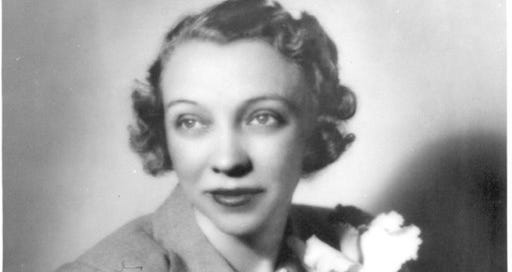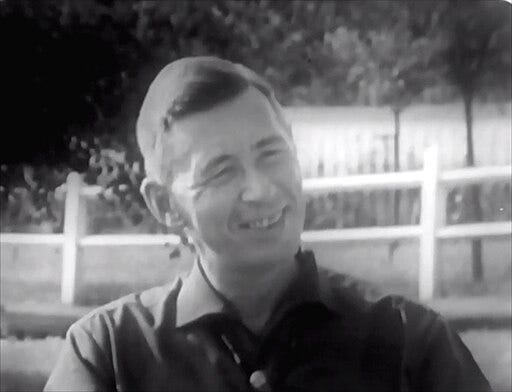Remembering Olive Ann Beech, an American business pioneer
Also, a plea for democratic reforms, World Schizophrenia Awareness Day and Hergé.
Olive Ann Beech, trailblazer
In the aviation industry, pilots are not the only people who soar. High achievers leave their mark in a number of other roles, too. Olive Ann Beech was one of those special people, a talented leader who become the first woman to run a Fortune 500 company.
Her story is worth telling.
In 1932, Olive Ann (Mellor) Beech and her husband, Walter Beech, co-founded the Beech Aircraft Corporation in Wichita, Kansas. Walter Beech was a pilot and an experienced entrepreneur in the airplane industry, having previously worked with Clyde Cessna in a venture called Travel Air Manufacturing.
During the Depression, starting an aircraft company was no easy feat. Fortunately for Walter Beech, Olive Ann was skilled in finance and management. While Walter focused on aircraft design, something he did very well, Olive Ann ran the day-to-day operations of the firm, something at which she excelled. They had met at Travel Air, where Olive Ann worked in the main office.
When Olive Ann started out in the business, things were not so easy for her. She was teased by the Travel Air employees for her lack of knowledge of aviation.
"When I first started working at Travel Air, I didn't know the empannage of an airplane from the wing. After a great deal of teasing from the staff when my letters were confused, I had our own chief engineer give me a complete breakdown drawing of an airplane." - Olive Ann Beech
The first aircraft built by Beech Aircraft was the Model 17, also known as the Staggerwing. It was designed to be one of the world's first executive planes, practical and advanced for its time. Fast and sleek, Beech airplanes also became known as the "limousines of the skies."
As orders for the Staggerwing aircraft started coming in, Olive Ann balanced the books, handled payroll and worked on long-term planning.
As aviation was developing In the 1920s and 30s, airplane races became quite popular. In 1936 the company decided to enter their Staggerwing in one of the most prestigious events, the Bendix Transcontinental Trophy Race, from New York to Los Angeles. Olive Ann thought it would be a good idea to hire two female pilots to fly for Beech. She believed it was an opportunity to demonstrate the quality of the aircraft. She wanted to show that, unlike other airplanes to the era, it was a well-engineered airplane to fly and did not require brute strength to operate. She also knew women were just as capable at flying as men.
Olive Ann selected Louise Thaden and Blance Noyes to pilot the Staggerwing. Their aircraft crossed the finish line in a time of twenty-four hours, fifty-five minutes, beating all crews, regardless of gender. The plane that arrived second was forty-five minutes behind.
The publicity from the win helped the company to grow. One year later, Beech Aircraft unveiled the Model 18, known as the Twin Beech. This aircraft also became a classic, and many are still in use today.
The war years saw the company grow further, due to the demand for aircraft and specialized equipment for the military.
Walter Beech died suddenly of a heart attack in 1950, but this did not slow the company’s growth, in part because Olive Ann was elected president and chairman of the board. In assuming these leadership roles, she become the first woman to run a Fortune 500 company. (The first female CEO of a Fortune 500 company was Katharine Graham of the Washington Post, more than twenty years later.)
Olive Ann continued her husband's spirit of innovation and successfully guided the firm in the development of new models, including the highly popular King Air and Bonanza. She stepped down as president in 1968, but stayed on the board of directors. In 1980 the company merged with Raytheon, and she eventually retired several years later, after more than fifty years in the business.
One of her strengths was that she knew how to find and hire good talent. Olive Ann surrounded herself with strong professionals. She also shunned the limelight and adapted a working style that gave her a level of control with which she was comfortable. Dave Stanwick, in a 2018 article entitled Olive Ann Beech: Queen of the Aircraft Industry, explained it this way:
She developed her own management techniques that were useful as a woman at the helm of a major aircraft manufacturer. She seldom held large group management meetings; when she did, she kept them short. Her technique allowed her to minimize vulnerability while maximizing authority. She ensured herself the upper hand and the home field advantage. In the morning she would scan the large stacks of mail that came in, scribbling a note on some letters: “See me.” Stories were told of grown men flinching when they were summoned by her secretary to stand on her blue carpet.
Olive Ann never learned to fly, but she won many honours and accolades, including the National Aeronautic Association’s Wright Brothers Memorial Trophy in 1980.
She died in 1993 at the age of 89.
Now known as Beechcraft, Walter and Olive Ann's company is still going strong more than ninety years after its founding. It is part of the Textron Aviation group, which also includes the equally famous company founded by their friend, Clyde Cessna.
—
Sources:
Krass, Peter (editor), The Book of Leadership Wisdom, John Wiley and Sons, Inc., 1998, pg. 102.
https://americanbusinesshistory.org/olive-ann-beech-queen-of-the-aircraft-industry/
https://www.britannica.com/biography/Olive-Ann-Beech
https://txtav.com/en/journey/articles/articles/beechcraft-a-history
Democracy: could we not work on some reforms?

Please allow me this little lament and a few minutes of wishful thinking.
The gradual degradation of democracy and the brittleness of the public discourse seems to be more evident today than at any other time in memory. Due to the rules of democratic systems, it appears to me that many western democracies are being driven increasingly by strategic electoral interests rather than the broader goals of good governance and the improvement of societies for the benefit of all citizens.
Something has shifted, and in the wrong direction.
While electoral and democratic reform has been briefly discussed in countries like Canada, it has not been undertaken in a determined way. I suspect this is primarily because political parties that hold power have a vested interest in the outcome and are not eager for changes that could erode their advantage.
But with the rise of autocratic regimes in different parts of the world and frustrations growing over the inability of democracies to focus on key issues, I think the time has come to think about our long-term democratic health.
In Western democracies, I believe a multi-pronged effort could be mounted, with constitutional experts, specialists and citizens from a variety of fields coming together to work on basic democratic reforms. Their role would be to devise, debate and shape future adjustments to our democratic systems. It could explore representation, legislative processes, divisions of powers, etc. This work would be undertaken at a distance and detached from the normal electoral cycle and the government of the day. The reform committees would be tasked to produce recommendations for changes that would then be modified through consultations and placed before the public in referenda-style processes. Due to the complexity of this work, it would need to be a medium-to-long-term process. All political parties would need to agree in advance to commit to this process and enact any changes approved by the agreed approval framework. The changes would be enacted within a certain pre-agreed time limit after ratification.
Perhaps these committees would even continue this work indefinitely, as the search for improvements in our imperfect democratic systems perhaps should be a perpetual thing, like quality control measures in manufacturing or software updates in computing.
I realize this process would be difficult and challenging, but isn't the future of a country worth working on? And wouldn't a number of engaged citizens be willing to work for some period of time, given adequate compensation, on such a project?
Is this just a technicolor daydream or something we can try?
I, for one, don’t want my country to sleepwalk into a crisis.

World Schizophrenia Awareness Day
This is the week in which the world focuses on serious mental illness. Every year on May 24th, on World Schizophrenia Awareness Day, a concerted effort is made to raise awareness about the illness in order to break the stigma that surrounds it.
As the Chair of the British Columbia Schizophrenia Society Foundation, I encourage you to learn more about schizophrenia. The illness generally presents itself early in life, often in the period between adolescence and adulthood. While there is no cure, it can be managed effectively through treatment, and early intervention is important. You can learn more about schizophrenia here.
If you know someone with a serious mental illness, please consider a donation so that the Schizophrenia Society can continue to provide its programs and services to affected families. Here’s how you can support the effort.
In recognition of World Schizophrenia Day, many activities and educational events have been scheduled. On May 24th, Selected public buildings in many cities were lit up in purple, the colour of the campaign.
Hergé’s legacy
On May 22nd, 1907, Georges Remi was born in Belgium. He grew up to be one of the most influential and popular cartoonists in history. In signing his work, he decided to invert the starting letters of his last and first names, RG, and write out the sound in French. His pen name therefore became "Hergé." You may have recognized him. He is best known for his comic book series The Adventures of Tintin, whose first book appeared in 1929. It enthralled youngsters and adults alike for the better part of the 20th Century.
Hergé pioneered the ligne claire style of drawing. Here's how Wikipedia explains it.
It uses clear strong lines, sometimes of varied width and no hatching, while contrast is downplayed as well. Cast shadows are often illuminated, and the style often features strong colours and a combination of cartoonish characters against a realistic background.
The charm of Hergé's art was in the interplay of well-paced plots that alternated drama and comedy, likeable characters and simplified realism through the ligne claire technique.
To give you an example, here’s the cover for one of Hergé’s 24 Tintin books.
Hergé's style was imitated by a number of famous designers and comic book artists, and his stories were appreciated by millions of devoted readers around the world.
For more about Tintin and Hergé, check out this site.
—
Sketch corner
This week, my quick sketch is literally of a corner, 41st and Yew Street, in Vancouver.
Thanks for reading Zanepost! I hope you have a great week.
-Renato














Thanks so much for reading my post, Sandy. I enjoyed writing about Beech and Hergé. If it's true that autocrats within have a far too strong a hold, then we must rise up. As citizens, we must demand more from our politicians and we must become engaged to let our voices be heard. We have to ask questions and expect some accountability. I think autocrats arise from the weakness in democracy. We have to do our part to strengthen it before it's too late.
It did indeed, take me some time to give me some time to read the post. I especially enjoyed reading and learning about Olive Ann Beech, and Herge. Very cool-both of them-they definitely forged their own paths and seemed to be ambivalent about expectations of others-remarkable in many quiet ways. And our democracy? I fear that the autocrats within have a far too strong a hold and presence already to let their power escape.